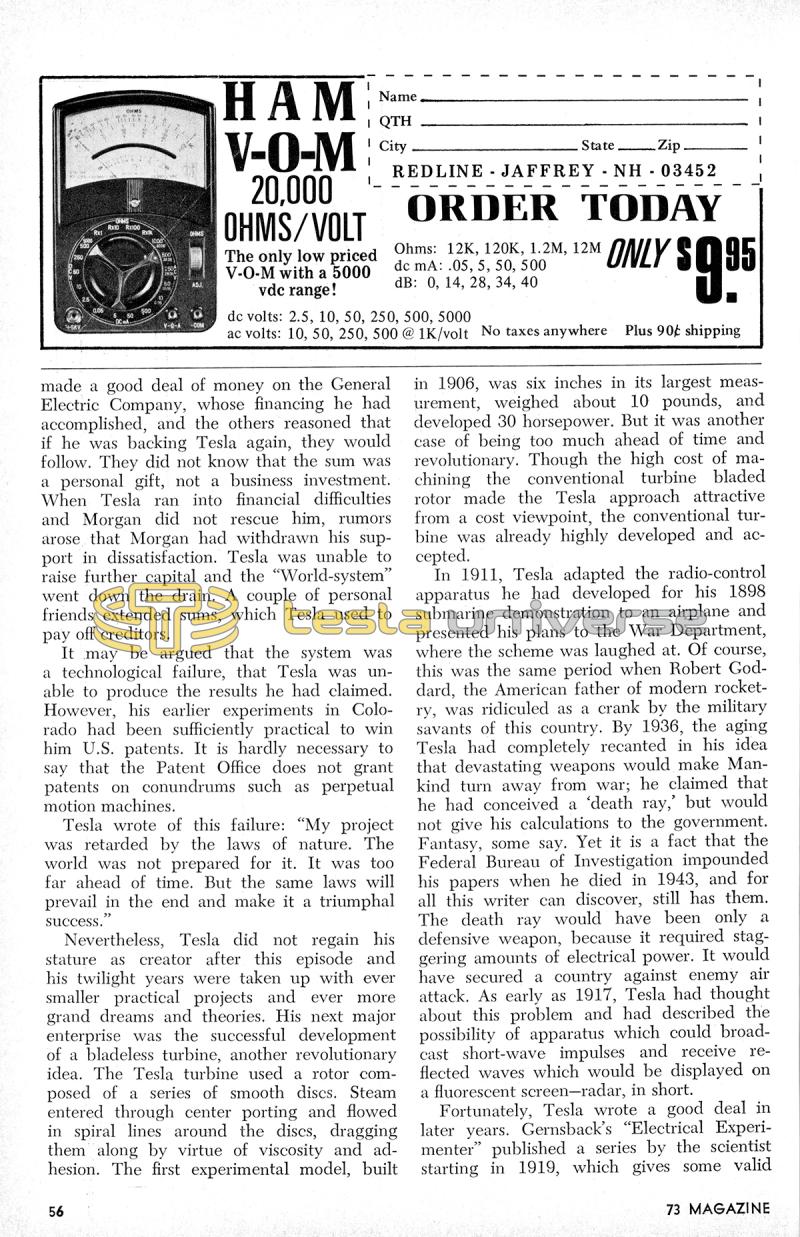
Nikola Tesla Articles
Nikola Tesla - Master of Electrical Energy Page 15
73 Magazine - February 1st, 1969
made a good deal of money on the General Electric Company, whose financing he had accomplished, and the others reasoned that if he was backing Tesla again, they would follow. They did not know that the sum was a personal gift, not a business investment. When Tesla ran into financial difficulties and Morgan did not rescue him, rumors arose that Morgan had withdrawn his support in dissatisfaction. Tesla was unable to raise further capital and the "World-system" went down the drain. A couple of personal friends extended sums, which Tesla used to pay off creditors.
It may be argued that the system was a technological failure, that Tesla was unable to produce the results he had claimed. However, his earlier experiments in Colorado had been sufficiently practical to win him U.S. patents. It is hardly necessary to say that the Patent Office does not grant patents on conundrums such as perpetual motion machines.
Tesla wrote of this failure: "My project was retarded by the laws of nature. The world was not prepared for it. It was too far ahead of time. But the same laws will prevail in the end and make it a triumphal success."
Nevertheless, Tesla did not regain his stature as creator after this episode and his twilight years were taken up with ever smaller practical projects and ever more grand dreams and theories. His next major enterprise was the successful development of a bladeless turbine, another revolutionary idea. The Tesla turbine used a rotor composed of a series of smooth discs. Steam entered through center porting and flowed in spiral lines around the discs, dragging them along by virtue of viscosity and adhesion. The first experimental model, built in 1906, was six inches in its largest measurement, weighed about 10 pounds, and developed 30 horsepower. But it was another case of being too much ahead of time and revolutionary. Though the high cost of machining the conventional turbine bladed rotor made the Tesla approach attractive from a cost viewpoint, the conventional turbine was already highly developed and accepted.
In 1911, Tesla adapted the radio-control apparatus he had developed for his 1898 submarine demonstration to an airplane and presented his plans to the War Department, where the scheme was laughed at. Of course, this was the same period when Robert Goddard, the American father of modern rocketry, was ridiculed as a crank by the military savants of this country. By 1936, the aging Tesla had completely recanted in his idea that devastating weapons would make Mankind turn away from war; he claimed that he had conceived a 'death ray,' but would not give his calculations to the government. Fantasy, some say. Yet it is a fact that the Federal Bureau of Investigation impounded his papers when he died in 43, and for all this writer can discover, still has them. The death ray would have been only a defensive weapon, because it required staggering amounts of electrical power. It would have secured a country against enemy air attack. As early as 1917, Tesla had thought about this problem and had described the possibility of apparatus which could broadcast short-wave impulses and receive reflected waves which would be displayed on a fluorescent screen - radar, in short.
Fortunately, Tesla wrote a good deal in later years. Gernsback's "Electrical Experimenter" published a series by the scientist starting in 1919, which gives some valid
